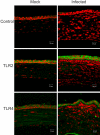Toll-like receptors involved in the pathogenesis of experimental Candida albicans keratitis
- PMID: 19933194
- PMCID: PMC2868407
- DOI: 10.1167/iovs.09-4330
Toll-like receptors involved in the pathogenesis of experimental Candida albicans keratitis
Abstract
Purpose. To investigate the expression and function of toll-like receptors (TLRs) during experimental keratomycosis. Methods. Scarified corneas of BALB/c mice were topically inoculated with Candida albicans and compared with control corneas by a murine gene microarray and immunostaining. Real-time reverse transcription polymerase chain reaction (RT-PCR) determined relative TLR gene expression in murine and human donor corneas. The scarified corneas of TLR2(-/-) mice, TLR4(-/-) mice, and C57BL/6J control mice were also inoculated with C. albicans, to determine relative severity, fungal load, and cytokine transcript levels. Results. TLR1, -2, -4, -6, and -13 were significantly upregulated (5- to 10-fold; P < 0.01) by microarray, and TLR1, -2, -4, and -13 were significantly increased (4- to 11-fold; P < 0.05) by real-time RT-PCR in BALB/c murine corneas. Similarly, TLR2, -6, and -13 were significantly upregulated (5- to 16-fold; P < or = 0.001) by real-time RT-PCR in C57BL/6J murine corneas the day after inoculation, and TLR2 and -13 remained significantly (P < 0.05) increased after 1 week. TLR2 transcript was also upregulated twofold (P = 0.04) in C. albicans-inoculated explanted human corneas. Although murine keratitis severity scores were similar, significantly more fungi were recovered from TLR2(-/-) mouse corneas (P = 0.04) than from TLR4(-/-) mouse corneas (P = 0.9). Tumor necrosis factor-alpha, interleukin 23, chemokine C-C ligands 3 and 4, and dectin-1 were significantly (P < 0.05) downregulated in C. albicans-infected corneas of TLR2(-/-) mice. Conclusions. TLR2 signals proinflammatory cytokines that control fungal growth during C. albicans keratitis. TLR13 may have an additional role in the innate immune response of murine corneal candidiasis.
Figures



Similar articles
-
Proinflammatory chemokines during Candida albicans keratitis.Exp Eye Res. 2010 Mar;90(3):413-9. doi: 10.1016/j.exer.2009.12.001. Epub 2009 Dec 11. Exp Eye Res. 2010. PMID: 20005222 Free PMC article.
-
Expression of small leucine-rich proteoglycans during experimental fungal keratitis.Cornea. 2010 Jun;29(6):674-9. doi: 10.1097/ICO.0b013e3181c29744. Cornea. 2010. PMID: 20458225
-
Corneal neovascularization during experimental fungal keratitis.Mol Vis. 2009 Sep 29;15:1988-96. Mol Vis. 2009. PMID: 19816603 Free PMC article.
-
Role of Toll-like receptors in systemic Candida albicans infections.Front Biosci (Landmark Ed). 2016 Jan 1;21(2):278-302. doi: 10.2741/4388. Front Biosci (Landmark Ed). 2016. PMID: 26709773 Review.
-
TLR2, but not TLR4, triggers cytokine production by murine cells in response to Candida albicans yeasts and hyphae.Microbes Infect. 2006 Jul;8(8):2299-304. doi: 10.1016/j.micinf.2006.03.014. Epub 2006 Jun 5. Microbes Infect. 2006. PMID: 16782386 Review.
Cited by
-
Effect of lactoferrin on murine embryo development created from lipopolysaccharide-treated sperm.J Vet Med Sci. 2021 Jul 28;83(7):1144-1146. doi: 10.1292/jvms.21-0251. Epub 2021 Jun 9. J Vet Med Sci. 2021. PMID: 34108340 Free PMC article.
-
Presence of Candida tropicalis on Staphylococcus epidermidis Biofilms Facilitated Biofilm Production and Candida Dissemination: An Impact of Fungi on Bacterial Biofilms.Front Cell Infect Microbiol. 2021 Oct 22;11:763239. doi: 10.3389/fcimb.2021.763239. eCollection 2021. Front Cell Infect Microbiol. 2021. PMID: 34746032 Free PMC article.
-
Inhibition of TREM-1 and Dectin-1 Alleviates the Severity of Fungal Keratitis by Modulating Innate Immune Responses.PLoS One. 2016 Mar 10;11(3):e0150114. doi: 10.1371/journal.pone.0150114. eCollection 2016. PLoS One. 2016. PMID: 26963514 Free PMC article. Clinical Trial.
-
Toll-like receptor-associated keratitis and strategies for its management.3 Biotech. 2015 Oct;5(5):611-619. doi: 10.1007/s13205-015-0280-y. Epub 2015 Feb 15. 3 Biotech. 2015. PMID: 28324534 Free PMC article. Review.
-
Human corneal epithelial cells produce antimicrobial peptides LL-37 and β-defensins in response to heat-killed Candida albicans.Ophthalmic Res. 2014;51(4):179-86. doi: 10.1159/000357977. Epub 2014 Mar 18. Ophthalmic Res. 2014. PMID: 24662332 Free PMC article.
References
-
- Johnson AC, Heinzel FP, Diaconu E, et al. Activation of toll-like receptor (TLR)2, TLR4, and TLR9 in the mammalian cornea induces MyD88-dependent corneal inflammation. Invest Ophthalmol Vis Sci 2005;46:589–595 - PubMed
Publication types
MeSH terms
Substances
Grants and funding
LinkOut - more resources
Full Text Sources
Other Literature Sources
Medical
Molecular Biology Databases

